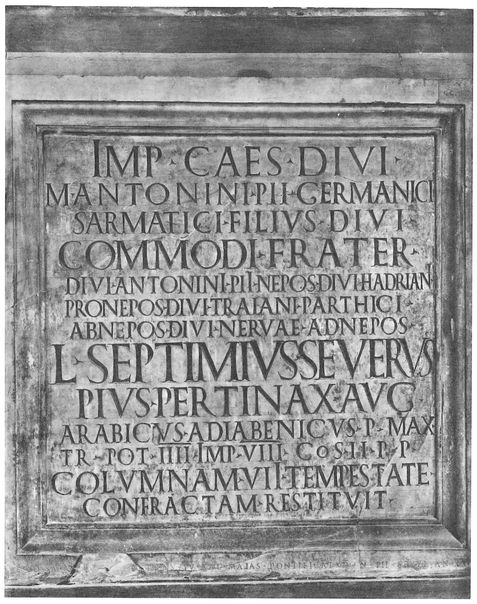Trajan's hexagonal basin and the channels leading to it.To the south of the harbour basins the Tiber is connected with the sea by a channel that is 45 meters wide [57]. It is known as the Fossa Traiani or Traiana, but it was made by Claudius. In the Middle Ages it was called Fiumicino ("Small river"), as is the modern village at the mouth of the channel (the river leading to Ostia was called Fiumara Grande). The Fossa created an artificial island between Ostia and Portus, called Isola Sacra ("Sacred Island") in late antiquity, and earlier also Assis.
Roman vaults in the north bank of the Fossa Traiana, discovered during work
on the road and bridge leading to the airport. Photo: Testaguzza 1970, p. 183.Two north-south running channels connect the harbour basins with the Fossa Traiana. The eastern one, starting at the corner of sides III and IV of Trajan's hexagon, is modern. It was dug in the early twentieth century, when the hexagon was restored by the Torlonia family. The western one [1] probably already formed part of the Claudian harbour, as did the Fossa Traiana. A plan of Antonio Labacco from 1559 shows two bridges over this channel. Whether these really existed has been doubted, even though Labacco mentions them explicitly in his accompanying text and provides the measurements.
The communicating channel with two bridges on the plan of Antonio Labacco from 1559. South is up.At the end of the connecting channel, to the west, is an east-west running inner harbour, called in Italian darsena [4]. Today it is an overgrown swamp. It is a rectangular basin measuring 45 x 24 meters, entered through an opening 9 meters wide on the east side. The oldest masonry belongs to the period of Claudius (opus reticulatum). This harbour was very deep, so it was meant for ships with a great draught, but it is too narrow for comfortable manoeuvring. The purpose remains unknown. The surrounding buildings are at a distance of 6 meters.
The darsena or inner harbour. Photo: Parco Archeologico di Ostia Antica.Beyond the inner harbour, channels led to the basins of Claudius and Trajan. The famous hexagonal basin of Trajan was at the centre of many warehouses. It has been suggested that it was designed by Apollodorus of Damascus, the architect of Trajan's forum in Rome. The basin is depicted with quite some detail on a coin struck by Trajan during his sixth consulship in 112 AD. We see the hexagon from above, from the lighthouse of Claudius one would think.
The Trajanic coin of Portus.In 2019 an intaglio was auctioned with a depiction of the hexagon (see "Harbour of Trajan - Temple of Liber Pater [32A], Forum Vinarium and Torlonia relief").
Intaglio with Trajan's hexagon. Original (left) and cast (right)
Private collection. Photo: Bertolami Auction Catalogue.The sides of the basin measure 357.77 meters, perhaps 1200 Roman feet. The maximum diameter is 715.54 meters. It was seven meters deep. The bottom was covered with stones, at the north end gradually sloping upwards, to reach a depth of only one meter at the edge of the basin.
Aerial view of the hexagonal basin, seen from the west. Photo: Portus Project.On the quays were travertine blocks with holes, used for mooring, fifteen meters apart (h. 1.10, w. 0.75, d. 2.00, diam. of holes 0.45). The basin could contain more than 100 ships (23 per side) that did not moor alongside the quays, but at a straight angle.
Side IV of the hexagon with mooring blocks. Photo: Lugli-Filibeck 1935, fig. 39.The basin was surrounded by a few wide treads, with a total width of some six meters, of which the actual quays took up three meters. Numbered columns with Latin numerals were also found around the basin, suggesting that the sides of the hexagon were subdivided into numbered sectors. On the quays was a wall, with five narrow doorways (1.80) on each side of the hexagon. The quays are not wide enough for cranes, and the doorways too narrow for wagons. Apparently the goods were unloaded and carried by porters. This can also be seen on several reliefs and mosaics. The wall facilitated the control of the flow of goods.
A marble column with the number XXIII at the corner of sides III and IV.
Photo: Testaguzza 1970, p. 171.In 1794 a marble base with an inscription was found at the corner of sides III and IV of the hexagon. The text records that Septimius Severus, in 196 AD, restored "a column broken by the force of a storm". As to the nature of the column, Russell Meiggs suggests that the column can be seen on the Trajanic coins depicting the hexagon, which show two tall columns surmounted by statues at either end of the side of the harbour facing the entrance, and possibly at other angles as well.

[Imp(erator) Caesar] D[ivi]
[M(arci) Antoni]NI PII GERMANI[ci]
[Sarmati]CI FILIVS DIVI
[C]OMMODI FRATER
DIVI ANTONINI PII NEPOS DIVI HADRIANI
PRONEPOS DIVI TRAIANI PARTHICI
ABNEPOS DIVI NERVAE ADNEPOS
L(ucius) SEPTIMIVS SEVERVS
PIVS PERTINAX AVG(ustus)
ARABICVS ADIABENICVS P(ontifex) M[ax(imus)]
TR(ibunicia) POT(estate) IIII IMP(erator) VIII
CO(n)S(ul) II P(ater) [p(atriae)]
COLVMNAM VII TEMPEST[atis]
CONFRACTAM RESTITV[it]The inscription from 196 AD, restored, with tempestate, as if it is the 7th column (see CIL XIV, 113).
Marble base. W. 1.13, h. 1.02. Vatican Museums. EDCS-05700113; EDR094047. Photo: EDCS.It is conceivable that the shape of the hexagonal fountain-basin in the centre of the Oceanus mosaic in Bad Kreuznach (Germany) was inspired by Trajan's basin.